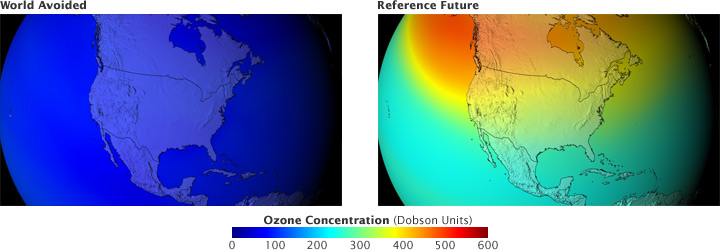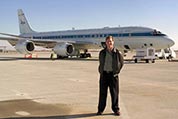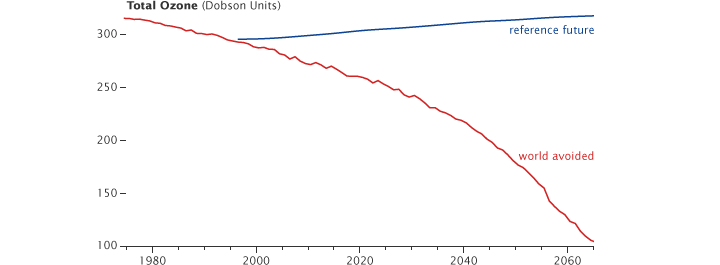

The year is 2065. Nearly two-thirds of Earth’s ozone is gone—not just over the poles, but everywhere. The infamous ozone hole over Antarctica, first discovered in the 1980s, is a year-round fixture, with a twin over the North Pole. The ultraviolet (UV) radiation falling on mid-latitude cities like Washington, D.C., is strong enough to cause sunburn in just five minutes. DNA-mutating UV radiation is up more than 500 percent, with likely harmful effects on plants, animals, and human skin cancer rates.

Such is the world we would have inherited if 193 nations had not agreed to ban ozone-depleting chemicals, according to atmospheric chemists from NASA’s Goddard Space Flight Center, the Johns Hopkins University, and the Netherlands Environmental Assessment Agency. Led by Goddard scientist Paul Newman, the team used a state-of-the-art model to learn “what might have been” if chlorofluorocarbons (CFCs) and similar chemicals had not been banned through the 1989 Montreal Protocol, the first-ever international agreement on regulation of chemical pollutants.

“Ozone science and monitoring have improved over the past two decades, and we have moved to a phase where we [scientists] need to be accountable,” said Newman, who is serving as a co-chair for the latest “state of the science” assessment report required by the terms of the Montreal Protocol. “We are at the point where we have to ask: Were we right about ozone? Did the regulations work? What kind of world was avoided by phasing out ozone-depleting substances?”
Ozone is Earth’s natural sunscreen, absorbing most of the incoming UV radiation from the sun and protecting life from DNA-damaging radiation. The gas is naturally produced and destroyed by sunlight-driven chemical reactions in the stratosphere, between about 10 and 50 kilometers above the Earth’s surface. Ozone is made when oxygen molecules (O2) absorb ultraviolet light and split into individual atoms (O), which join with other O2 molecules to make O3—ozone. Ozone is destroyed when molecules containing nitrogen, hydrogen, chlorine, or bromine catalyze reactions that pair a single O atom with ozone (O3) to make 2 molecules of O2. It is a system with a natural balance.
But chlorofluorocarbons—invented in the early 1890s, and first used in the 1930s as refrigerants and propellants for chemical sprays—upset that balance. While CFCs are not reactive at Earth’s surface, they become quite destructive when they are exposed to ultraviolet light in the upper stratosphere. There, CFCs and their bromine-based counterparts break up into elemental chlorine and bromine that repeatedly catalyze ozone destruction. Worst of all, such ozone-depleting chemicals can reside for several decades in the atmosphere before breaking down.

The chemical phenomenon opened up a springtime hole over Antarctica in the 1980s. Each winter, stratospheric temperatures are cold enough to form clouds, even though the air is very dry. Chemical reactions on the surfaces of the cloud particles convert chlorine from a relatively unreactive form into highly reactive form. The September sunrise over Antarctica triggers ozone-destroying reactions by these reactive kinds of chlorine, and the ozone concentration over the South Pole drops from about 300 Dobson Units to as low as 100 Dobson Units. (See “What is a Dobson Unit?”) By late spring, the rising temperature stops the ozone destruction cycle. The ozone layer rebounds over summer and fall. The ozone hole phenomenon opened the eyes of the world to the effects of human activity on the atmosphere.
In the new analysis, Newman and colleagues set out to predict ozone losses as if nothing had been done to stop them. The team started with the Goddard Earth Observing System Chemistry-Climate Model, an earth system model of atmospheric circulation that accounts for variations in solar energy, atmospheric chemical reactions, temperature changes and winds, and interactions between the stratosphere, where ozone is found, and the troposphere, the layer of atmosphere closest to Earth. Their “world avoided” simulation took months of computer time to process.
The researchers let global emissions of CFCs and similar compounds in the model world increase by 3 percent per year, the rate at which they were growing before regulation in the late 1980s. Then they let the simulated world turn from 1975 to 2065.

With continued production of CFCs, ozone levels worldwide would have dropped to dangerously low levels. (NASA images by the GSFC Scientific Visualization Studio.)
By the simulated year 2020, 17 percent of global ozone is destroyed, and an ozone hole forms each year over the Arctic as well as the Antarctic. By 2040, the ozone “hole”—concentrations below 220 Dobson Units—is global. The UV index in mid-latitude cities reaches 15 around noon on a clear summer day (10 is considered extreme today).

Computer models predict that global average ozone will return to levels above 300 Dobson Units by 2064 (the reference future, blue line). In contrast, sustained increases in the level of CFCs and other ozone-destroying chemicals would have reduced global ozone below 100 Dobson Units (world avoided, red line). (Graph adapted from Newman et al., 2009.)

Global reduction in ozone levels would lead to a huge increase in dangerous ultraviolet (UV) radiation, with summer noontime UV index values at mid-latitudes rising to 30—three times the level currently considered extreme. (Graph adapted from Newman et al., 2009.)

In the 2050s, something strange happens: ozone levels in the stratosphere over the tropics collapse to near zero in a span of six years. According to Goddard scientist and study co-author Richard Stolarski, who was among the pioneers of atmospheric ozone chemistry in 1970s, the rapid, near-total ozone destruction is similar to what happens over Antarctica today.
Seeing a similar process occur over the tropics was surprising, says Stolarski, “because we hadn’t expected the tropical stratosphere would get cold enough to form stratospheric clouds.” The dramatic cooling appears to be the result of two processes. “Ozone absorbs UV energy, which causes the surrounding atmosphere to warm,” explains Stolarski. “So, by itself, loss of ozone leads to cooling, which is something we expected to see.”
More surprising, says Stolarski, is that the temperature change intensified the stratosphere’s large-scale, slow-moving circulation pattern. In that circulation, air from the lower stratosphere rises into the upper stratosphere at tropical latitudes, spreads toward the poles, and sinks. As air rises, it cools. As the circulation strengthened, the amount of cooling increased, allowing stratospheric clouds—today confined to polar latitudes—to form over the tropics. Runaway ozone destruction followed.
By the end of the model run in 2065, global ozone drops to less than 110 DU, a 67 percent drop from the 1970s. Year-round Arctic polar values hover between 50 and 100 (down from 500 in 1960). The intensity of UV radiation at Earth’s surface doubles; at certain shorter wavelengths, intensity rises by as much as 10,000 times. Skin cancer rates would soar.
“Our world avoided calculation goes a little beyond what I thought would happen,” said Stolarski. “The quantities may not be absolutely correct, but the basic results clearly indicate what could have happened to the atmosphere. And models sometimes show you something you weren’t expecting, like the precipitous drop in the tropics.”
“We simulated a world avoided,” said Newman, “and it’s a world we should be glad we avoided.”
The real world has been somewhat kinder. Production of ozone-depleting substances was finally halted in 1992, though their abundance is only beginning to decline because the chemicals can reside in the atmosphere for 50 to 100 years. The peak abundance of CFCs in the atmosphere occurred around 2000, and has decreased by roughly 4 percent to date.

Stratospheric ozone has been depleted by 5 to 6 percent at middle latitudes, but has somewhat rebounded in recent years. The largest recorded Antarctic ozone hole was recorded in 2006, with holes of slightly smaller size since then. Newman, Stolarski, and other colleagues have used their model to simulate how the real world ozone layer will recover as well. Because of climate change from greenhouse gases, they say, the ozone layer will probably not look exactly like it did in the 1970s.

“I didn’t think that the Montreal Protocol would work as well as it has, but I was pretty naive about the politics,” Stolarski added. “The Montreal Protocol is a remarkable international agreement that should be studied by those involved with global warming and the attempts to reach international agreement on that topic.”